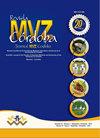Estructura comunitaria de metazoos parásitos en la doncella Hemanthias peruanus (Serranidae) del norte de Perú
IF 0.3
4区 农林科学
Q4 AGRICULTURE, DAIRY & ANIMAL SCIENCE
引用次数: 0
Abstract
Objective. To assess the community structure of helminths and parasitic crustaceans in the splittail bass Hemanthias peruanus (Steindachner, 1875) from northern Peru. Materials and methods. 75 specimens (34 males and 41 females) of H. peruanus were captured from Puerto Cabo Blanco, Piura, Peru. Total length and sex data of the fish were recorded. For the analysis of the parasitic community, the ecological parasitological indices, aggregation indices, alpha diversity indices and association between the biometric parameters of the fish and the parasitological indices were calculated. Results. The percentage of total prevalence in maidens infected with at least one parasitic metazoan species was 65.33%, that is, 49 parasitized hosts. The community component of the parasitic eumetazoan fauna in the evaluated fish was dominated by the presence of ectoparasites (three species of monogeneans and one species of isopod). Endoparasite abundance (two species of trematodes, one species of tapeworms and one species of acanthocephalan) was comparatively low. Biotic factors such as fish length and sex were not found to be related to parasitological indices of any parasitic species. The lack of association is probably due to the influence of other biotic or abiotic factors. The most prevalent parasites presented an aggregate type distribution. The Chao-1 estimator indicates that the expected richness was eight. Conclusions. We registered H. peruanus as a new host for Ceratothoa gaudichaudii, Corynosoma australe, Parancylodiscoides signifer, Pronotogrammella scholzi and Scolex pleuronectis.秘鲁北部女仆Hemanthias peruanus (Serranidae)寄生后生动物的群落结构
目标。目的探讨秘鲁北部裂尾鲈鱼(Hemanthias peruanus, Steindachner, 1875)中蠕虫和寄生甲壳类动物的群落结构。材料和方法。在秘鲁皮乌拉卡波布兰科港共捕获秘鲁蠓75只(雄性34只,雌性41只)。记录鱼的总长度和性别数据。对寄生群落进行了分析,计算了生态寄生指数、聚集指数、α多样性指数以及鱼类生物特征参数与寄生指数的相关性。结果。至少感染一种后生寄生虫的少女总患病率为65.33%,即被寄生宿主49人。鱼类寄生真生动物群落组成以外寄生虫为主(单系3种,等足类1种)。体内寄生虫(吸虫2种、绦虫1种、棘头虫1种)丰度较低。鱼类体长、性别等生物因子未发现与任一寄生物种的寄生学指标相关。缺乏相关性可能是由于其他生物或非生物因素的影响。最流行的寄生虫呈聚集型分布。Chao-1估计表明,期望丰富度为8。结论。我们将秘鲁赤蝽登记为gaudichadii角鼻虫、australe角鼻虫、parancylodiides signifer、prootogrammella scholzi和scouronectis的新寄主。
本文章由计算机程序翻译,如有差异,请以英文原文为准。
求助全文
约1分钟内获得全文
求助全文
来源期刊

Revista Mvz Cordoba
农林科学-奶制品与动物科学
CiteScore
0.70
自引率
0.00%
发文量
41
审稿时长
6-12 weeks
期刊介绍:
The Journal MVZ Córdoba is an open access international scientific journal financed and edited by the University of Córdoba (Colombia). The journal publishes quarterly, continuously in PDF, XML, Epub, original articles, literature reviews, brief communications and clinical cases, peer-reviewed (double-blind) in Spanish and English, which are related to the agricultural and veterinary sciences. The journal is directed to natural and legal persons of veterinary medicine, animal husbandry, public health, epidemiology, aquaculture, biology, basic biomedical sciences and biotechnology and constitutes a space for academic and scientific discussion around the work of professionals in Veterinary Medicine and Zootechnics. Four-monthly publication.
"The Journal MVZ Córdoba supports the policies for registration of clinical trials of the World Health Organization (WHO) and the International Committee of Medical Journal Editors (ICMJE), since it recognizes the importance of these initiatives for international registration and dissemination. of information about clinical studies, in open access. As a result, since 2007, the journal MVZ Córdoba only publishes clinical research articles that have received an identification number in one of the Clinical Trial Registries validated by the criteria established by WHO and ICMJE, whose addresses are available in the ICMJE website. The identification number is recorded at the end of the summary. "
 求助内容:
求助内容: 应助结果提醒方式:
应助结果提醒方式:


